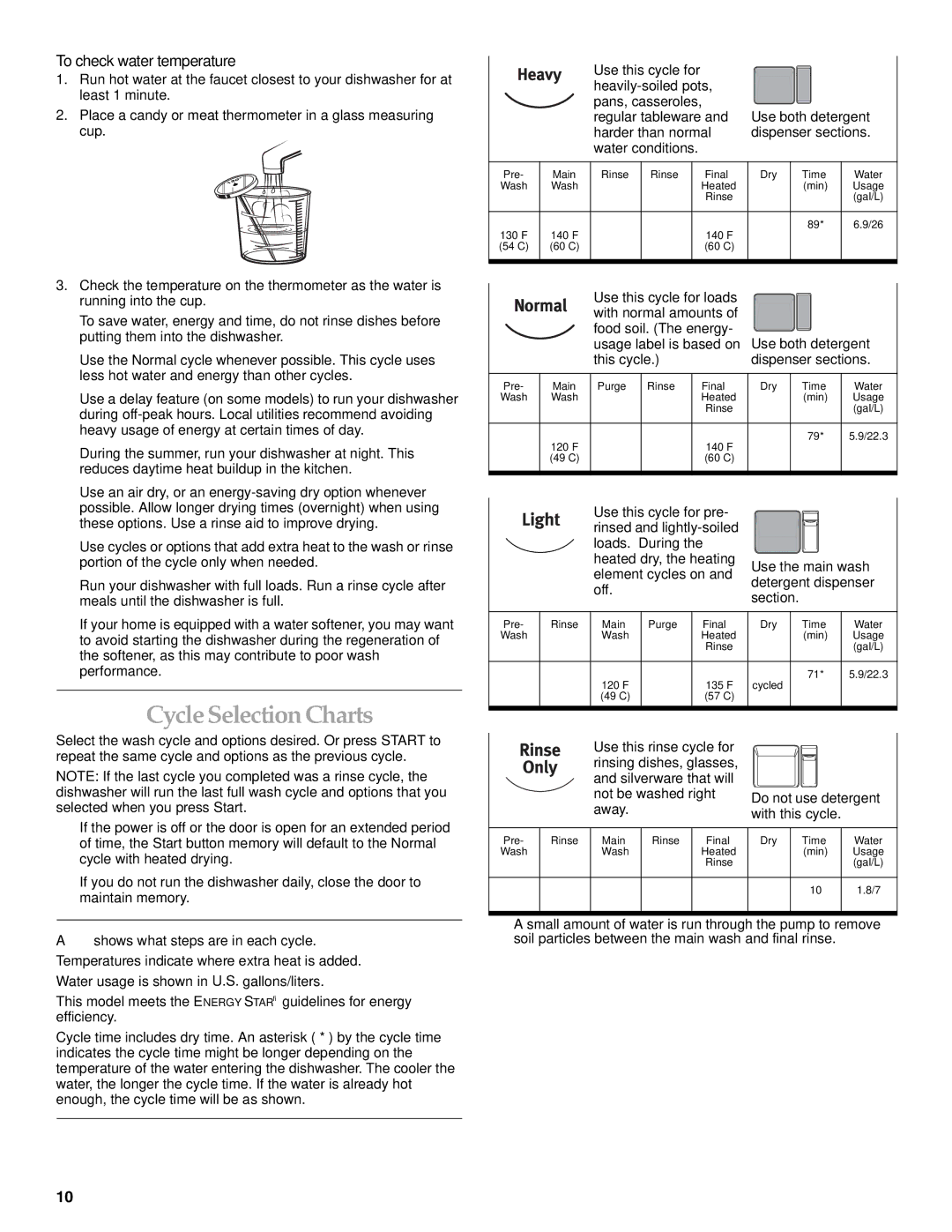
To check water temperature
1.Run hot water at the faucet closest to your dishwasher for at least 1 minute.
2.Place a candy or meat thermometer in a glass measuring cup.
3.Check the temperature on the thermometer as the water is running into the cup.
■To save water, energy and time, do not rinse dishes before putting them into the dishwasher.
■Use the Normal cycle whenever possible. This cycle uses less hot water and energy than other cycles.
■Use a delay feature (on some models) to run your dishwasher during
■During the summer, run your dishwasher at night. This reduces daytime heat buildup in the kitchen.
■Use an air dry, or an
■Use cycles or options that add extra heat to the wash or rinse portion of the cycle only when needed.
■Run your dishwasher with full loads. Run a rinse cycle after meals until the dishwasher is full.
■If your home is equipped with a water softener, you may want to avoid starting the dishwasher during the regeneration of the softener, as this may contribute to poor wash performance.
Cycle Selection Charts
Select the wash cycle and options desired. Or press START to repeat the same cycle and options as the previous cycle.
NOTE: If the last cycle you completed was a rinse cycle, the dishwasher will run the last full wash cycle and options that you selected when you press Start.
■If the power is off or the door is open for an extended period of time, the Start button memory will default to the Normal cycle with heated drying.
■If you do not run the dishwasher daily, close the door to maintain memory.
A “●” shows what steps are in each cycle.
Temperatures indicate where extra heat is added.
Water usage is shown in U.S. gallons/liters.
This model meets the ENERGY STAR® guidelines for energy efficiency.
Cycle time includes dry time. An asterisk ( * ) by the cycle time indicates the cycle time might be longer depending on the temperature of the water entering the dishwasher. The cooler the water, the longer the cycle time. If the water is already hot enough, the cycle time will be as shown.
|
| Use this cycle for |
|
|
| ||
|
|
|
|
| |||
|
| pans, casseroles, | Use both detergent | ||||
|
| regular tableware and | |||||
|
| harder than normal | dispenser sections. | ||||
|
| water conditions. |
|
|
|
| |
Pre- | Main | Rinse | Rinse | Final | Dry | Time | Water |
Wash | Wash |
|
| Heated |
| (min) | Usage |
|
|
|
| Rinse |
|
| (gal/L) |
● | ● | ● |
| ● | ● | 89* | 6.9/26 |
130°F | 140°F |
|
| 140°F |
|
|
|
(54°C) | (60°C) |
|
| (60°C) |
|
|
|
|
| Use this cycle for loads |
|
|
| ||
|
| with normal amounts of |
|
|
| ||
|
| food soil. (The energy- | Use both detergent | ||||
|
| usage label is based on | |||||
|
| this cycle.) |
| dispenser sections. | |||
Pre- | Main | Purge† | Rinse | Final | Dry | Time | Water |
Wash | Wash |
|
| Heated |
| (min) | Usage |
|
|
|
| Rinse |
|
| (gal/L) |
● | ● | ● |
| ● | ● | 79* | 5.9/22.3 |
| 120°F |
|
| 140°F |
|
|
|
| (49°C) |
|
| (60°C) |
|
|
|
|
| Use this cycle for pre- |
|
|
| ||
|
| rinsed and |
|
|
| ||
|
| loads. During the |
|
|
| ||
|
| heated dry, the heating | Use the main wash | ||||
|
| element cycles on and | detergent dispenser | ||||
|
| off. |
|
| |||
|
|
|
| section. |
| ||
|
|
|
|
|
| ||
Pre- | Rinse | Main | Purge† | Final | Dry | Time | Water |
Wash |
| Wash |
| Heated |
| (min) | Usage |
|
|
|
| Rinse |
|
| (gal/L) |
| ● | ● | ● | ● | ● | 71* | 5.9/22.3 |
|
| 120°F |
| 135°F | cycled |
|
|
|
| (49°C) |
| (57°C) |
|
|
|
|
| Use this rinse cycle for |
|
|
| ||
|
| rinsing dishes, glasses, |
|
|
| ||
|
| and silverware that will |
|
|
| ||
|
| not be washed right | Do not use detergent | ||||
|
| away. |
|
| with this cycle. | ||
Pre- | Rinse | Main | Rinse | Final | Dry | Time | Water |
Wash |
| Wash |
| Heated |
| (min) | Usage |
|
|
|
| Rinse |
|
| (gal/L) |
|
|
| ● |
|
| 10 | 1.8/7 |
†A small amount of water is run through the pump to remove soil particles between the main wash and final rinse.
10
